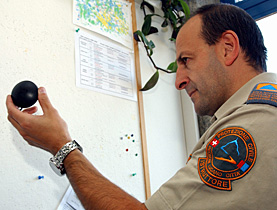
Swiss lean towards new radon norms

Hundreds of thousands of Swiss homes are subject to higher levels of the potentially harmful gas radon than is allowed under World Health Organization (WHO) guidelines.
The Swiss authorities are drawing up an action plan to take into account the recommendations. The problem has become more serious, having extended from the alpine areas across the country.
Radon, which is invisible and has no smell, arises from the natural decay of uranium under the ground. It, too, is radioactive and is dangerous to humans.
The gas can seep into houses through porous ground or through cracks and fissures. The more permeable the soil, the easier it is for radon to permeate into closed or badly ventilated areas.
The effects can be serious: around a tenth of Switzerland’s 2,700 lung cancer deaths a year are caused by a prolonged exposure to radon.
Recent epidemiological studies carried out in Europe, the United States and China have shown that its victims are not just miners, as previously thought.
Home danger
“Most radon-induced lung cancers occur from low- and medium-dose exposures in people’s homes,” said Maria Neira, director of the public health and environment department at the WHO.
At the end of September, the organisation therefore drastically reduced the maximum levels of radon allowed in homes from 1,000 to 100 becquerel per cubic metre (bq/m³). Becquerels are the SI derived unit of radioactivity. If this standard cannot be met, levels should not exceed 300 bq/m³, it said.
The change is going to have repercussions for Switzerland, where the limit has been fixed by law at 1,000 bq/m³.
“The problem is more serious than thought: the risk zones are not just in [Alpine areas] such as Ticino, Graubünden and the Jura – it extends across the whole country,” Christophe Murith, head of the radiological risk section of the Federal Health Office, told swissinfo.ch.
“In 1994 Switzerland carried out a detection programme in at-risk communes and made improvements to buildings which did not conform to the standard. We have therefore acquired a certain experience in the matter,” he added.
Action plan
According to Murith, lowering the limit to 100 bq/m³ across Switzerland would mean making improvements to around half a million buildings.”This is practically unfeasible,” he said.
“We are currently in the process of drawing up a new action plan which takes into account the latest WHO recommendations.”
It won’t be necessary to intervene straightaway in the buildings which are found to be above the new limits, he explained. The owners will instead be asked to take steps within a certain time, depending on the seriousness of the situation.
They cannot be forced to act immediately, he added, but they could perhaps be persuaded to take action during their next renovation work. The limit of 100 bq/m³ will only therefore be applied to new buildings.
To limit additional costs, the Federal Health Office advises that radon protection measures be included in the national programmes for promoting energy-efficient buildings.
Training and awareness courses for architects and engineers on the dangers of radon are also planned at the Federal Institute of Technology in Lausanne (EPFL).
Recommendations
The Radon Competence Centre at the SUPSI University of Applied Sciences and Arts of Southern Switzerland in Ticino recommends that new buildings be equipped with a cement foundation slab that doesn’t have joints and is hermetically sealed.
In zones with higher concentrations of radon, it also suggests providing under-foundation ventilation and accurately monitoring the ventilation systems and ducts.
Although they might be burdensome, every measure is important. The WHO says that every 100 bq/m³ of radon radiation increases the chance of developing a tumour by 16 per cent.
“A dose of 1,000 bq/m³ corresponds to the maximum limit that professionals are allowed to be exposed to, for example in a nuclear power station,” said Murith. “Personally I wouldn’t want my children to live in this kind of environment.”
Luigi Jorio, swissinfo.ch (Translated from Italian by Isobel Leybold-Johnson)
Switzerland’s 1,000 bq/m³ limit is set down in law, unlike many other European countries which just set recommendations. All buildings above this limit have to be renovated to 400 bq/m³ .
In Italy there is no fixed limit yet, but reference is made to the European Union recommendation of 200 bq/m³.
Recommended limits elsewhere: Germany (250 bq/m³), Britain (200 bq/m³), United States (150 bq/m³), the Netherlands (20 bq/m³).
Radon is an element in the decay chain of uranium, which is ubiquitous in the ground. The natural decay of uranium gives rise to products including radium and radon.
Radon gas atoms can in turn disintegrate, producing polonium, bismuth and lead. These decay products, which are also radioactive, attach themselves to airborne particles and tend to accumulate in enclosed spaces. When inhaled, they can be deposited in the lungs and irradiate lung tissue, possibly leading to lung cancer.
The highest concentration of radon in Switzerland is found in the Alps, in particular in Ticino, Valais and Graubünden.
In Switzerland, radon is the second-largest cause of lung cancer after smoking.
Of the around 2,700 deaths per year from lung cancer, 200-300 are attributed to radon.
(Source: Federal Health Office)
Studies in seismic risk zones have found evidence to suggest that measuring radon levels can be useful in understanding whether there is going to be a large earthquake.
Movement of the earth’s lower layers, which cause quakes, could be preceded by abnormal expulsions of radon.
Several days before the devastating tremor at Aquila in Italy in April 2009, researcher Giampaolo Giuliani predicted the quake from his monitoring of radon concentrations. His announcement caused controversy, also because the scientific community is divided on the issue.

In compliance with the JTI standards
More: SWI swissinfo.ch certified by the Journalism Trust Initiative






























You can find an overview of ongoing debates with our journalists here . Please join us!
If you want to start a conversation about a topic raised in this article or want to report factual errors, email us at english@swissinfo.ch.